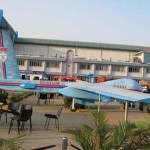It’s been happening since April, 2024, at least. In Ukraine, robots have been battling and destroying other robots – with their human operators sitting safely behind control screens, miles behind the front line.
Perhaps the first engagement was in the Avdiivka sector, near Donetsk a few months ago. Three Russian Unmanned Ground Vehicles (UGVs) were approaching Ukrainian trenches. The small, tracked armoured vehicles were armed with automatic grenade launchers or machine guns (accounts differ).
They never reached their destination; a vigilant recce drone from the Ukrainian 47th Mechanized Brigade spotted them and raised the alarm – all three Russian vehicles were then attacked and destroyed by Ukrainian First-Person View (FPV) kamikaze drones.
This is perhaps the first recorded combat engagement where no humans were present. At least in the vicinity.
The Russian UGVs are thought to have been their most successful model so far; the Marker. This 3-ton unmanned vehicle has been built in both wheeled and tracked versions– and can mount a range of weapons including anti-tank guided missiles. It has earlier been seen laying anti-tank mines far in front of Russian positions.
Details of vehicle guidance, target acquisition and fire control are not available, but an alarming German media report claimed that the Marker has AI-enabled systems that can identify friendly troops and vehicles from their camouflage uniforms or insignias, and also recognize enemy troops and vehicles. In short, the Marker can fight autonomously without a human in the loop – a huge advantage if the radio link to the vehicle is lost or jammed.
This is what a German reporter claims. He also says that the Marker is being touted as an independent tank hunter.
The proof, they say, is in the pudding – or in this case the blooding. So far, it’s the Marker that’s been bloodied.
KISS – Keep It Simple, Stupid
My personal view is that Russian technology is not there – yet. A case in point is another promising UGV, the Uran 9.
Produced by the famed Kalashnikov Group, The Uran 9 is much heavier unmanned vehicle that mounts a 30mm auto cannon, a machine gun, 4 ATGMs and a set of thermobaric rockets for use against ground targets. A full suite of sensors includes IR imaging and a laser rangefinder.
It did not work. Perhaps that’s an exaggeration, but the vehicle (and there are at least 350 of them built to date) was tested a few years ago during the Syrian Civil war and it failed to carry out most of the tasks assigned to it. Whether the overload was on the machine or the man behind it is not known, but the Russians seem to have reverted to the KISS principle.
Hence the much smaller Marker. Hence the Nerekhta. Less complex machines with a single machine gun or grenade launcher. Still, very valuable in a scouting or support role.
What is clearly apparent is that the Russian have ambitions for their growing UGV fleet and a variety of roles for them to perform – from mine laying to mine clearance, from scouting to tank hunting. Certainly, no other nation has invested as much in them. And no one else has such a variety of prototypes up and running at this point in time.
|
Russian UGV Prototypes |
|
| Name | Function |
| Platforma-M | Combat UGV |
| Nerekhta | Combat UGV |
| Soratnik | Combat UGV |
| Kungas | UGV swarm concept |
| Skarabey | De-mining UGV (short-range) |
| Sfera | De-mining UGV (short-range) |
| Marker | UGV RDT&E prototype |
| Uran-6 | De-mining UGV (short-range) |
| Uran-9 | Combat UGV |
| Uran-14 | Firefighting UGV |
| Udar | Combat UGV based on the BMP-3 platform |
| Prokhod -1 | Heavy de-mining UGV |
| Shturm | Heavy UGV for urban combat based on the T-72 tank platform |
–
The Empire Strikes Back
Aside from a wide array of UGVs, the Russians are no slouches with their own kamikaze drones, either. Let me tell you about another robot vs robot engagement.
On 30th May, a video emerged of a Russian kamikaze drone attacking a Ukrainian USV or Unmanned Surface Vessel (sorry, I don’t make up the terminology – get used to it). These are the robot speedboats that have done so much damage to the Russian Black Sea Fleet – travelling considerable distances to do so.
The footage shows the Russian FPV drone skimming low – just a few feet above the water as it approaches the speeding Ukrainian USV, and slams into the boat’s starboard side. The footage ends with the explosion and another robot bites the dust – or in this case, the waves. And the skill of the Russian operator is impressive; this is no slow-moving tank target. One can imagine the armies of the future; game-playing geeks to a man. Virtual reality headsets strapped on. Caffeinated energy drinks at their elbows. Fingers caressing controllers as they take on their robot enemies many miles away.
Perhaps India, too, had better step up its game. Yes, we have a border surveillance UGV – the ECARS going into production and others on the drawing board. We have large aerial recce drones – some with the ability to launch weapons. But we have a long, long way to go. And face it, robots are going to dominate every dimension – air, land, sea, undersea. And it’s happening much faster than you think.









